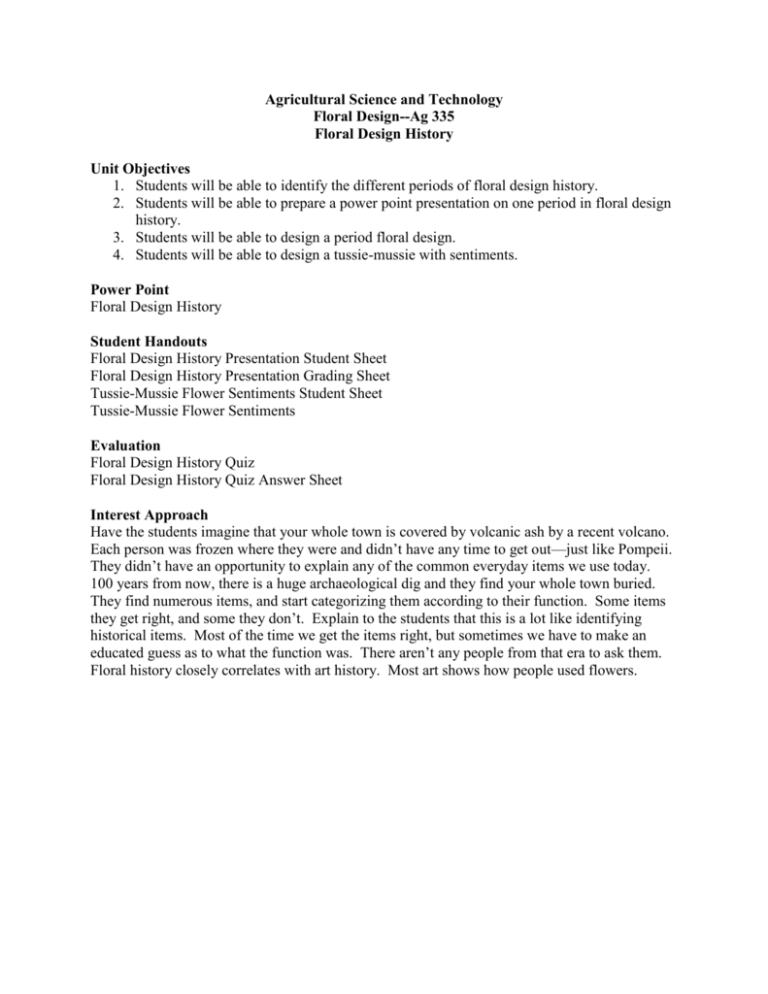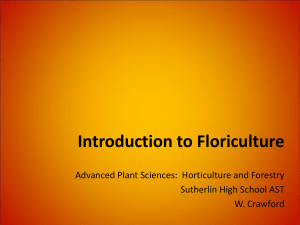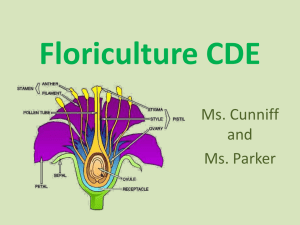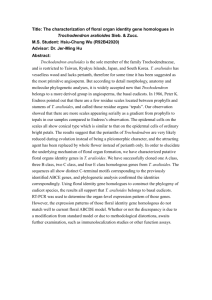History of Floral Design Assignment
advertisement

Agricultural Science and Technology Floral Design--Ag 335 Floral Design History Unit Objectives 1. Students will be able to identify the different periods of floral design history. 2. Students will be able to prepare a power point presentation on one period in floral design history. 3. Students will be able to design a period floral design. 4. Students will be able to design a tussie-mussie with sentiments. Power Point Floral Design History Student Handouts Floral Design History Presentation Student Sheet Floral Design History Presentation Grading Sheet Tussie-Mussie Flower Sentiments Student Sheet Tussie-Mussie Flower Sentiments Evaluation Floral Design History Quiz Floral Design History Quiz Answer Sheet Interest Approach Have the students imagine that your whole town is covered by volcanic ash by a recent volcano. Each person was frozen where they were and didn’t have any time to get out—just like Pompeii. They didn’t have an opportunity to explain any of the common everyday items we use today. 100 years from now, there is a huge archaeological dig and they find your whole town buried. They find numerous items, and start categorizing them according to their function. Some items they get right, and some they don’t. Explain to the students that this is a lot like identifying historical items. Most of the time we get the items right, but sometimes we have to make an educated guess as to what the function was. There aren’t any people from that era to ask them. Floral history closely correlates with art history. Most art shows how people used flowers. Teaching Content Floral Design History Historical Periods: Egyptian 2800-28 BC: Repetition and alteration Lotus flower—Egyptian goddess Isis traced back as far as 2500 b.c. Separate primary colors Egyptian flower vases made to hold up flowers with weaker stems like lotus Festivals and feasts Faience—type of finely ground silicate Mostly used wide-mouth bowls During time of pharaohs lotus, papyrus and palm tree most commonly portrayed members of the plant kingdom Greek (Classical) 600-146 BC: Garlands-exchanged by lovers, worn at weddings and hung on door to denote the birth of a son Wreaths-a symbol of allegiance and dedication rewarded to athletes, poets, civic leaders and victorious soldiers and sailors Cornucopia --symbol of abundance Scattered petals Mythology Chaplet-head piece Professional flower makers and sellers Roman 28 BC-AD 325: Continued the use of garlands and wreaths (fuller, wider) Day to day life and celebrations Rose petals piled on floor Nero and Cleopatra used them extravagantly during festivities lavish and fantastic strewn on banquet tables and couches, streets and lakes Grew roses among hot water pipes to supply all demand Sachet Fragrance Byzantine 320-600 AD: Garlands of fruit Symmetrical conical designs with concentric rings of fruit, stones, jewels, metals. Tree compositions Middle Ages 476-1400 AD: Warring feudal lords state of unrest Monks grew herbs were well acquainted with many of the beautiful everyday flowers illuminated in manuscripts Everyday life—wild and cultivated used in food, drink, medicine Fragrant flowers strewn on ground and freshen air Art belonged to the church—stained glass windows, mosaics, tapestries, sculpture, paintings and illuminated religious books Renaissance 1400-1600 AD: Resurgence and flourishing of the arts Religious symbolism 7 flowers representing the 7 stations of the cross Seven fully-opened columbine flowers represent the seven gifts of the holy spirit—wisdom, understanding, counsel, strength, knowledge, true godliness and holy fear purity represented by certain flowers—usually the white lily (Virgin Mary) because it appeared in so many Annunciation paintings, it soon became known as the Madonna Lily Annunciation where angel appears to Mary rose represented sacred or profane love Old garden book for growing, freshening and arranging flowers—Flora overo Cultura di Fiori Bouquets usually pyramidal and full Containers made for arranging flowers removable lid so flower arrangement can be lifted and flowers recut every 3rd day tearred affect so short stemmed flowers could be placed on top Baroque 1600-1775 AD: Influence of artists The “S” curve or Hogarth curve Lavish designs--bright colors Large, overly proportioned designs in big, heavy containers Not for church or nobility any longer—middle class could have flowers—due to trading and redistribution of wealth with new world Dutch-Flemish 1550-1760 AD: Holland and Belgium Tulip imported from Turkey New flowers-- particularly “out of season” greenhouse grown flowers Paintings included composite groups of flowers—painted during different seasons Terra-cotta Age of great scientific, botanical and horticultural discoveries Delftware-copied Chinese porcelain vases in blue and white but less expensive—named after Netherland city where it was invented French Periods: French Baroque 1600’s: Louis XIV--effeminate extravagance Art evolved around the aristocracy Topiary balls or trees Chateau of Versailles large rooms decorated with elaborate wood and stone carvings marble fireplaces and floors decorative flower arrangements large in scale Enormous conservatory stored 3000 orange trees during the winter using hothouses to supply indoor plants for massive decoration French Rococo 1700’s: Louis XIV mistress-Antoinette Poisson, the Marquis do Pompadour had great influence. Asymmetrical, curvilinear, formal crescent (C curve) “Rock and shell” curving lines Predominant subtle colors: apricot, peach, cream, rose, gray, sage green, yellow, beige, turquoise, and powder blue Delicate accessories Louis XVI late 1700’s: Strong feminine influence of Marie Antoinette—delicate, cool colors, highlighted with gold, more simple containers than previous Empire 1804-1814: Strong use of neoclassical design ideas Napoleon Bonaparte Masculine designs, dramatic, militaristic, dictator-oriented symbols predominate Heavy massive designs and containers with large boldly colored flowers English Periods: English-Georgian Period 1714-1760: Named after English Kings George I,II, III Full, strongly stylized symmetrical bouquets, oval to triangular shapes Formal and symmetrical—tightly arranged “tuzzy-muzzy” or nosegay “tuzzy” refers to old English word for knot of flowers Nosegay to carry the sweet scents—relief from unsanitary surroundings Fragrance to rid air of contagious and infectious diseases Decolletage—flowers around neckline of a dress Bough pot—flower filled container set in the fireplace in non heated seasons Wedgwood--English potter Josiah Wedgwood—fine ceramic ware used during this season—special holes to hold flowers in stiff and formal shape Victorian Period 1820-1901: “Of all modes of enlivening the aspect of an apartment, there is perhaps none more pleasing than the sight of plants and flowers suitably arranged and distributed. They are ornaments of Nature’s own producing, which inspire an interest apart from their beauty, by the care and attention required for their culture. They employ the hand, delight the eye, and inform and edify the mind, and, unlike many artificial objects, the enjoyment and instruction they afford are within the reach of all, the poor may partake as well as the rich.” --Article written in Jan 1855 Named after Queen Victoria who reined in England from 1837 to 1901 Floral design recognized as an art Establishing rules of design led to the development of today’s floral industry Girls taught to arrange flowers and make tussie-mussies as well as grow, preserve, press, draw and paint flowers Make artificial flowers using shells, wax, feathers, hair, textiles, and beads Bouquets poorly designed. “Airless,”overstuffed and flat, symmetrical, with no particular focal point. Short-stemmed flowers Nosegays more popular—conveyed sentiments silent messages depending on what went into them Posey holders—small container to hold nosegay made of metals, steel, and alloy, ivory, glass, painted porcelain, amber, tortoiseshell, and mother of pearl, inlaid with jewels, pearls, and small mirrors Included two small chains—one with ring for finger, other pin attached to secure flowers Bosom bottles—small container to hold flowers used as an accent for clothing worn at decolletage Complementary color schemes—blue next to orange and so on Sand used to place flowers into Early American Periods: (Closely correlated with the simultaneous periods in Europe) Early American Period 1620-1720: Simplified versions of the European designs Colonists were avid gardeners Common people who lived a “puritan” existence Common household containers Bouquets made of wildflowers, often including dried materials. Colonial Williamsburg Period 1714-1780: Life more sophisticated Trade provided a richer choice of containers and materials Designs copied from floral prints and tapestries Designs were fan-shaped or mounded Fruit and flowers placed for centerpiece American Federal Period 1780-1820: The neoclassical, Empire New freedom and independence Designs were influenced by the delicate French, the masculine French, and an emphasis on the individual merits of each flower. American Victorian 1845-1900: Romantic era Copied European Victorian Epergne Oriental Influence: Place emphasis on individual form, texture, and color of plant material Great attention to negative space and line Chinese Style: China known as “The Flowery Kingdom.” Unstructured and naturalistic, but require careful thought and planning. 1.art of contemplation—Confucius Confucius—real enjoyment consists in simplicity there is a distraction that comes from viewing too much beauty serenity to be gained from savoring one thing at a time shadow of a tree on a pond—structure, seasons, strength a few flowers in a vase can conjure up the whole life-history of a plant, as well as display the beauty of perfect blooms 2.preservation of life-Buddhism prohibits taking of life—cut flowers sparingly Not conquering nature, following it. Gardens have strategic flowering plants instead of masses—areas for contemplation 3.floral symbolism-folklore all flowers are feminine because of fragile beauty and are given women’s names tree peony most revered of all flowers liked to depict the seasons Japanese Style: a.k.a. Ikebana Highly formalized and follows strict rules of construction--Ikenobo Adapted from ancient Chinese art and steeped in tradition and symbolism. Materials placed in a manner reflecting how they are found in nature. Arrangements emphasize simplicity and line Ono-no-Imoko—founded Ikenobo—flower arranging school Items found in nature would complement the flowers, rocks, pine, bamboo, cypress, cedar water Exclusively by men at first—priest then nobility and warrior class to find tranquility of mind and relief from life’s tension in the handling and observation of flowers In the doing not it the decorating Contests and books of instruction Flowers never used out of season—water, branches Elements of a design face each other Heaven, man, earth (shin, soe, tai) Shin one and one half times the height of the container Soe two thirds the length of Shin Tai is two thirds the length of soe line Modern Floral Arranging: Art Nouveau 1890-1910: Curvilinear lines Patterned after nature Shape of plants or flowers as well as the human form Asymmetrical flower arrangement Art Deco 1925-1930: Derived from 1925 Paris world’s Fair exhibition. Characterized as strong, streamlined, geometric lines, forms and patterns, including zigzags, pyramids, and sunburst motifs Known as le style 25 Free-Form Expression 1950’s: A modern, natural appearance. Expressive with both a feeling of movement and of freedom Use of driftwood and other figurines in designs Geometric Mass Design 1960-1970’s: Tight geometric bouquets. Include mass and line. Contemporary refers to the time of the present or of recent times o Called modern because they generally are different than whatever style was previously popular Cultures that have had the greatest influence in today’s design: Oriental Line European Mass Line-Mass “American,” or “Western Style” Floral Design History: Berrall, Julia S. A History of Flower Arrangement. Viking Press, Inc. 1968. Hunter, Norah T., The Art of Floral Design Second Edition Delmar 2000. Chapter 1 Student Activities 1. Floral Design History Presentation Students will choose one period in floral design to research. They will present their findings to the class with a power point presentation. Please see accompanying sheet for details. Equipment: Floral Design History Presentation Student Sheet Floral Design History Presentation Grading Sheet 2. Period Floral Design This assignment may be used in conjunction with Floral Design History Presentation or separately. Students will choose a period in Floral Design History and develop an arrangement or design that would most likely be seen during that era. Present various flowers and container assortment to the class and have them choose what would best fit that area. There are several ways to obtain the materials—assign to students, have a clean out the cooler day—use any left-overs. Purchase several different silk flowers during a sale and use for this purpose. Students may disassemble silk arrangements when finished and use for the next year. Have students present their completed design to the class—sharing what they found out about the design period, what they struggled with, and if the added modern interpretation to the design. Equipment: Various flower assortment—may be silk or fresh Various container assortment Wet or dry floral foam Design tools 3. Design a Tussie-mussie Have the students design a tussie mussie with sentiments by deciding either what flowers they will present or what sentiment they want to convey. Use the hand out provided. Equipment: Tussie-Mussie Flower Sentiments Student Sheet Tussie-Mussie Flower Sentiments Crayons, colored pencils and/or markers References Berrall, Julia S. A History of Flower Arrangement. Viking Press, Inc. 1968. Hunter, Norah T., The Art of Floral Design Second Edition Delmar 2000. Chapter 1 Laufer, Geraldine Adamich. Tussie-Mussies Workman Publishing Company, Inc. 1993 Komoda, Shusui & Horst Pointer Idebana Spirt & Technique. Kyodo Printing 1983 Floral Design History of Floral Design Assignment Due Date: Value: REQUIREMENTS: 150 points The history of floral design assignment must include: 1. Historical Time Period 2. Historical Dates 3. Flowers used 4. Foliage used 5. Photos of era—at least 3 6. Interesting pieces of history included during time period 7. Two quiz questions for your era 8. Prepare a power point presentation 9. Present history time period with the class 10. References used COMMENTS: The class will be discussing the history of floral design. This assignment requires students to gain hands-on experience by researching different time periods in history. Learning about Floral Design History helps students gain knowledge about what flowers, foliage, and containers were successfully used previously. NAME_________________________ HISTORY OF FLORAL DESIGN ASSIGNMENT: FLORAL DESIGN HISTORY ASSIGNMENT DUE DATE: POINTS: 150 Points REQUIREMENTS: STUDENTS WILL study one period in floral design history and prepare a power point presentation for the class. Requirement Possible Historical Time Period ........................................................ 5 Historical Dates .................................................................. 5 Flowers used .................................................................... 10 Foliage used ..................................................................... 10 Photos of era—at least 3 ................................................... 15 Interesting pieces of history included during time period .... 10 Two quiz questions for your era ......................................... 10 Power point presentation ................................................... 30 Presentation ..................................................................... 20 References used ............................................................... 10 Overall ............................................................................. 25 Earned _________ _________ _________ _________ _________ _________ _________ _________ _________ _________ _________ Sub-Total ..................................................................... 150 _________ Late deductions (10%/day) .............................................. 0 _________ Extra Credit Poster (up to 25) .......................................... 0 _________ Total ......................................................................... 150 _________ Design a Tussie-Mussie to Convey Sentiments 1. 2. 3. 4. Study the Tussie-mussie Flower Sentiments. Choose flowers or sentiments you wish to convey Design a rough sketch of the tussie-mussie Write out the sentiments of your tussie-mussie design Tussie-Mussie Sketch: (using color increases your chance of a better grade) Tussie-Mussie Sentiments: Tussie Mussie Flower Sentiments Laufer, Geraldine Adamich. Tussie-Mussies Workman Publishing Company, Inc. 1993 Flower Agapanthus Ageratum Allium/flowering onion almond Alyssum, sweet Amaranth, globe Amaryllis Anemone Anthurium/flamingo flower Apple Arborvitae Aster Astilbe Azalea Baby’s breath Bachelor’s button/cornflower Balloon flower/platycodon Balsam/impatiens Bamboo Basil Begonia Bells of Ireland Blackberry Black-eyed Susan Bleeding heart Blueberry Bramble Buds Buttercup Calla lily Candytuft Carnation Carnation-pink Carnation-striped Chamomile Cherry Chrysanthemum Cinnamon Clover Columbine Corn Corn flower Crocus Daffodil Dahlia Sentiment Love letters Delay Unity, humility, patience Hope, lover’s charm, heedlessness Worth beyond beauty Immortality Splendid beauty, pride, haughtiness Truth, sincerity, abandonment, expectation The heart, little boy flower Preference, fame speaks him great and good, perpetual concord, temptation Unchanging friendship, tree of life Variety, afterthought, beauty in retirement, sentimental recollections I’ll still be waiting Love, romance, first love, moderation Pure heart, festivity, gaiety Felicity, healing properties, delicacy Return of a friend is desired Ardent love, impatience, felicity Loyalty, steadfastness, uprightness, strength through pliancy Best wishes, hatred Highly popular, long beautiful, unrequited love, Beware, I am fanciful Whimsy Dangerous pride Justice Elegance, fidelity Prayer, protection Remorse Promise of good things to come Rich in charms, cheerfulness, ingratitude Magnificent beauty, feminine modesty Indifference Admiration, fascination, ardent and pure love, bonds of love, unfading beauty, woman’s love Maternal love, lively and pure affection, beauty, pride refusal Energy in adversity, comfort, patience Sweetness of character derived from good works, good education, Cheerfulness, optimism, long life, joy joviality, mirth Love, beauty, my fortune is yours Good luck, good education, hard work, industry I cannot give thee up!, resolved to win Riches, gift of mother earth Delicacy, felicity, healing properties Youthful gladness, pleasure of hope Regard, respect, chivalry, gracefulness Gratitude, dignity, pomp, my gratitude exceeds your care, instability Daisy Dandelion Daylily Dead leaves Delphinium Dill Dogwood Elderberry Euonymus Fennel Fern Fig Forsythia Foxglove Freesia Fuchsia Galax Gardenia Garlic Geranium Ginger Gladiolus Grape Grass Heather Hen and chicks Holly Hollyhock Honeysuckle Hops Hosta Hyacinth Hydrangea Hyssop Ice plant Impatiens Ivy Jasmine Juniper Kalanchoe Lamb’s ears Larkspur Lavender Lemon Innocence, simplicity Wishes come true Flirt, beauty Sadness, melancholy Well-being, sweetness, beauty, return of a friend is desired Irresistible, soothing Love undiminished by adversity, faithfulness Kindness, compassion, zeal Your image is engraven on my heart, long life Worthy of all praise, force, strength, to grow thin, thinness Fascination, sincerity The womb, longevity, peace and prosperity Good nature Insincerity, a wish, decision, I am not ambitious for myself but for you Innocence Taste Friendship, encouragement Transport of joy, ecstasy, I love you in secret, feminine charm, purity, peace Protection, strength, courage, good luck Comfort, you are childish, melancholy, deceit, stupidity, childhood, health Safe, pleasant, comforting, warming Generosity, strength of character, you pierce my heart Carousing, abandon, intoxication, prosperity and plenty, domestic happiness The fleeting quality of life, submission Admiration, wishes come true, protection from danger Welcome-home-husband-however-drunk-ye-be Foresight, good will, domestic happiness Fruitfulness Bonds of love, generous and devoted affection Beer, mirth, rest, sleep Devotion Play games, sport Devotion, remembrance, boastfulness Cleansing Your looks freeze me! Rejected suitor impatience Wedded love, fidelity, constancy, friendship, trustfulness, ambition, tenacity Transport of joy, amiability Welcome to new home, protection, asylum Popularity Softness, gentleness, surprise, support Ardent attachment, levity, swiftness Devotion, luck, success, happiness, distrust, soothes the trembling and passions of the heart, ardent attachment Fidelity in love, zeal, discretion Lilac Lily, tiger Lily-of-the-valley Lisianthus Lupine Magnolia Maple Marigold Mint Moss Myrtle Narcissus Nasturtium Nettle Oak Oats Love Orchid Pansy Parsley Passion flower Pea Peach Pear Peony Peppermint Periwinkle Phlox Pincushion flower Pine Pine cone Pinks Plum Pokeweed Pomegranate poppy Queen Anne’s lace Ragweed Ragwort Ranunculus Raspberry Rhododendron Rhubarb Rose Youth, acceptance, love, beauty, modesty Wealth, pride Return of happiness, purity, delicacy Showy Imagination, voraciousness Sweetness, beauty, perseverance Reserve, elegance, keys, beauty Health, joy, remembrance, constancy, the sun, affection, grief, jealously misery, cares Warmth of feeling Maternal love Love, marriage, married bliss, fidelity, passion, peace, home, joy Egotism, self-love, self-esteem Patriotism Cruelty, slander Hospitality, strength, independence, prosperity, longevity, truth, durability, steadfastness, virtue Music Peace Luxury, love, refinement, nobility, scholarship, beauty, numerous progeny Thoughts, loving thoughts, you occupy my thoughts Festivity, thanks, gratitude, useful knowledge, feasting Christian faith, religious superstition Departure, happy marriage, profits in business, respect Longevity, I am your captive, feminine softness, ruddy health Benevolent justice, affection, health, hope, good government, wise administration Beauty, welcome, bashfulness, hands full of cash Warmth, cordiality Love, pleasures of memory Our souls are united, proposal of love, sweet dreams Unfortunate attachment, widowhood, I have lost all Loyalty, vigorous life, endurance, boldness, longevity, warm friendship, spiritual energy, mobility Fertility, life Lively and pure affection, fascination, sweetness, boldness, newlyweds, dignity, taste, talent Courage, happiness, hardiness perseverance, marriage, fertility A joke, poking fun Royalty, mature elegance, posterity, foppishness Forgetfulness, sleep, oblivion, Haven, protection, I will return Nuisance I am humble but proud You are rich in attractions, I am dazzled by your charms Remorse, fulfillment, gentle-heartedness Danger Advice, fidelity Love, beauty, congratulations, reward of virtue, May you be pleased and your sorrows mine! Grace, joy, You are gentle, friendship, silence, unity Rosemary Sage Hypericum Shamrock Snapdragon Soapwort Spruce Statice Stock Stonecrop/sedum Strawberry Sumac Sweet pea Sweet William Thistle Thyme Tuberose Tulip Verbena Violet Virginia creeper Walnut Wheat Willow Wisteria Yarrow Yew Zinnia Remembrance, your presence revives me Domestic virtue, wisdom, skill, esteem You are a prophet, protection, superstition Luck, light-heartedness, Ireland No! presumption, you are dazzling, but dangerous Cleanliness Farewell, hope in adversity Never-ceasing remembrance, gratitude Promptness, lasting beauty Tranquility, welcome-home-husband-however-drunk-ye-be Perfect goodness, you are delicious, foresight, future promise Resoluteness, intellectual excellence Departure, delicate, meet me Childhood, memory, gallantry, finesse, dexterity Austerity, independence, grief Activity, bravery, courage, strength Dangerous love Fame, charity, happy years Faithfulness Modesty, humility, simplicity I cling to you both in sunshine and in shade Intellect, strength of mind, stratagem Friendliness, prosperity, riches, worldly goods Freedom, serenity, friendship, patience Welcome fair stranger, I cling to thee, helpless and delicate War, cure for heartache, health, sorrow, heals wounds Sorrow Thoughts of absent friends Name________________________ Date_________________________ Floral Design Management Floral Design History Quiz 81 points Matching Match the following items to the period in history where they originated. (Periods may be used more than once, or not used at all) (3 points each) A. B. C. D. E. F. G. H. I. J. K. L. Egyptian Greek Roman Byzantine Middle Ages Renaissance Baroque Dutch Flemish Feminine French Masculine French (Empire) English-Georgian Victorian M. Early American N. Colonial Williamsburg O. American Federal P. American Victorian Q. Chinese R. Japanese S. Art Nouveau T. Art Deco U. Free-Form Expression V. Geometric Mass W. Contemporary 1. Tight geometric bouquet________ 15. Cornucopia ________ 2. Heaven, man, earth 16. Epergne ________ ________ 3. Household containers ________ 17. “The Flowery Kingdom” ________ 4. Sachet ________ 18. Lotus flower ________ 5. Tuzzy-muzzy ________ 19. Driftwood 6. Madonna lily ________ 20. Seven stations on the cross________ 7. Le style 25 ________ 21. Pastels, dainty ________ 8. Hogarth curve ________ 22. Garlands ________ 9. Posey holders ________ 23. Terra-cotta ________ 10. Wreaths ________ 24. Bosom bottles ________ 11. Militaristic designs ________ 25. Copied European Victorian________ 12. Conical designs ________ 26. Preservation of Life________ 13. Bough pot ________ 27. Time of the present________ 14. Nosegay conveyed sentiments ________ ________ Floral Design Management Floral Design History Quiz Master 81 points Matching Match the following items to the period in history where they originated. (Periods may be used more than once, or not used at all) (3 points each) A. B. C. D. E. F. G. H. I. J. K. L. Egyptian Greek Roman Byzantine Middle Ages Renaissance Baroque Dutch Flemish Feminine French Masculine French (Empire) English-Georgian Victorian 1. Tight geometric bouquet V. 2. Heaven, man, earth R. 3. Household containers M. 4. Sachet C. 5. Tuzzy-muzzy K. 6. Madonna lily F. 7. Le style 25 T. 8. Hogarth curve G. 9. Posey holders L. 10. Wreaths B. 11. Militaristic designs J. 12. Conical designs D. 13. Bough pot K. 14. Nosegay conveyed sentiments L. M. Early American N. Colonial Williamsburg O. American Federal P. American Victorian Q. Chinese R. Japanese S. Art Nouveau T. Art Deco U. Free-Form Expression V. Geometric Mass W. Contemporary 15. Cornucopia 16. Epergne 17. “The Flowery Kingdom” 18. Lotus flower 19. Driftwood 20. Seven stations on the cross 21. Pastels, dainty 22. Garlands 23. Terra-cotta 24. Bosom bottles 25. Copied European Victorian 26. Preservation of Life 27. Time of the present B. P. Q. A. U. F. I. B. H. L. P. Q. W.








